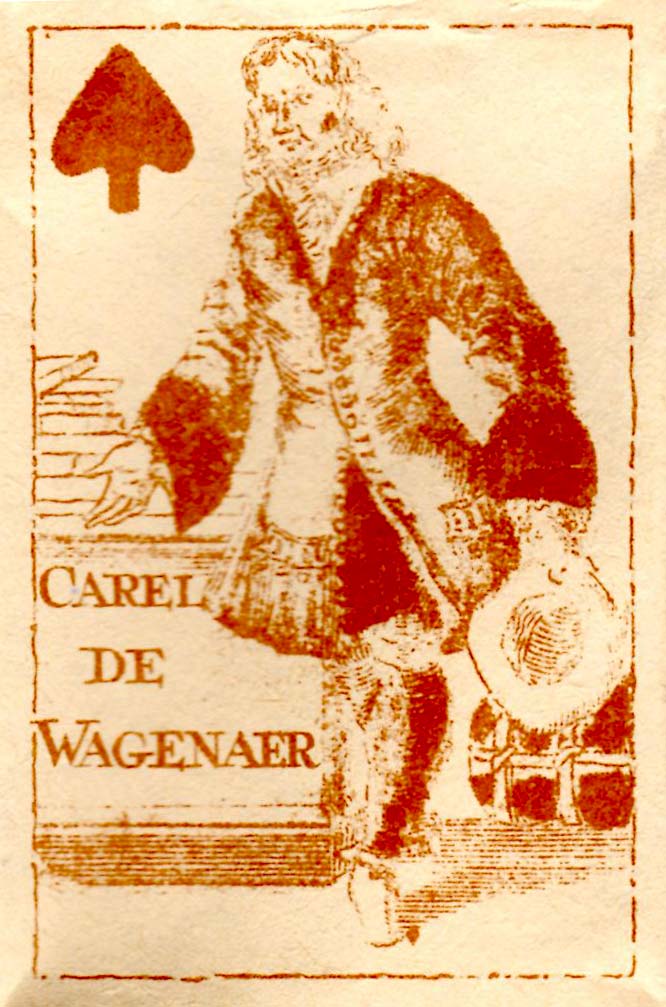Carel de Wagenaer
Facsimile edition of cards first published by Carel de Wagenaer, Amsterdam in c.1698
Carel de Wagenaer was one of the earliest playing card manufacturers in The Netherlands, based in Amsterdam towards the end of the 17th century. He was probably of French origin. In 1697 Carel De Wagenaer’s shop “In de Gekroonde Haan” (Crowned Cock) was situated in the Kalverstraat near the Osse sluice. He advertised 3 sorts of cards: large sized French, small sized Dutch and tea cards (patience). Following the earlier trend of depicting classical heroes on the court cards, and evolving the new trend for educational and political decks, in this example the rulers of Europe are matched to the hierarchy of the playing cards.
The ♥ King and Queen of hearts depict William III and Mary II of England. The ♦ King of diamonds depicts the Spanish monarch Charles II, with his second wife Maria Anna of Neuburg as the Queen. Don Rodrigo was a governor at that time. Holy Roman Emperor Leopold I appears as the ♣ King of clubs, accompanied by his third wife Eleonor Magdalene of Neuburg as the Queen. Heyduck appears to be an outlaw or freedom fighter. Carel de Wagenaer himself appears as the ♠ Jack of spades, making a gesture of deferential respect, accompanied by King Louis XIV of France and his wife with a rosary and what look like angel wings as they were both devout Catholics. The numeral cards are plain.



Above: modern facsimile edition of cards first published by Carel de Wagenaer, Amsterdam in c.1698. The publisher of the facsimile is not known, probably c.1975. Images courtesy Kathey Renault.
As an addendum to this article the following story was translated by Joop Muller:
In 1698 Antoni de Winter made an agreement with the manufacturer of playing cards Carel de Wagenaer regarding a partnership to publish certain kinds of playing cards. De Winter would engrave them and De Wagenaer would make-up the printed cards. On December 8 De Winter lodged a complaint at the notary Van Duynkerken who issued a warrant against De Wagenaer. The complaint was that De Winter had delivered 900 prints for ‘tea cards’ (patience cards) and later another 300. Together that would bring 8 grosses and 48 single decks, of which De Winter would receive half. Despite of all his efforts De Winter hadn’t received more than 20 dozen and two single decks. In the warrant De Wagenaer was held responsible for the financial loss (a lot of decks could have been sold already) and De Winter also announced that he would retreat from the partnership and keep half of the common copper plates. De Wagenaer answered that he would deliver all when De Winter had paid him.
REFERENCES and ACKNOWLEDGEMENTS
Hoffmann, Detlef: The Playing Card, an illustrated history, Edition Leipzig, 1973
Van Eeghen, Dr. I. H. (editor): AMSTELODAMUM, Amsterdam, 1976, pp 28-29 online here►
Thanks to Joop Muller for additional research. Some images of the original deck can be viewed on Joop Muller’s website►

By Simon Wintle
Member since February 01, 1996
I am the founder of The World of Playing Cards (est. 1996), a website dedicated to the history, artistry and cultural significance of playing cards and tarot. Over the years I have researched various areas of the subject, acquired and traded collections and contributed as a committee member of the IPCS and graphics editor of The Playing-Card journal. Having lived in Chile, England, Wales, and now Spain, these experiences have shaped my work and passion for playing cards. Amongst my achievements is producing a limited-edition replica of a 17th-century English pack using woodblocks and stencils—a labour of love. Today, the World of Playing Cards is a global collaborative project, with my son Adam serving as the technical driving force behind its development. His innovative efforts have helped shape the site into the thriving hub it is today. You are warmly invited to become a contributor and share your enthusiasm.
Related Articles

Jeu Révolutionnaire
Court cards and aces from a French Revolutionary pack by Pinaut, Paris, c.1794.

Polish Kings and Queens – red deck
Polish kings and queens plus the court jester, illustrated in a distinctive style inspired by histor...

Doppel-Deutsche Karten by Bratří Willnerové, Teplice
This deck from local manufacturer Bratří Willnerová offers a standard version of the popular Central...

French Revolutionary cards by Pinaut
Seven cards from a French Revolutionary pack by Pinaut featuring characters from classical antiquity...

Zürcher Festspiel 1903
Swiss-suited pack designed by Robert Hardmeyer featuring figures from art and politics.

Jim Lyngvild playing cards
Photographs of Danish royalty as imagined by fashion designer Jim Lyngvild.

Barok
Dutch pack from the 1950s with colourful Baroque courts, reprinted in 1983.

Victorian grocer’s scale plate
Large flat plate decorated with highly coloured English cards and royal arms.

Verkeers Kwartet
A helpful quartet game celebrating the 75th anniversary of road safety exams making traffic safer.

Pam is the Knave of Clubs
Playing cards as metaphors in 18th century art - from fate, chance and social hierarchy t...

Dr Sacheverell
Dr. Henry Sacheverell's impeachment in 1710 sparked widespread public unrest and political upheaval,...

Cartes politiques : Jeu d'actualité
Political playing cards published by Grimaud et Chartier, Paris, 1872.

Politiker-Skat by Bubec
Caricatures of world leaders, including many German politicians, by the artist Bubec.

Le Poker Politique
French politicians and various world leaders caricatured by the German artist Bubec.

Rouen Pattern - Portrait Rouennais
An attractive XV century French-suited design from Rouen became the standard English & Anglo-America...

Royal Britain
Pack devised by Pietro Alligo depicting English monarchs from Alfred the Great to Elizabeth II.
Most Popular
Our top articles from the past 28 days

